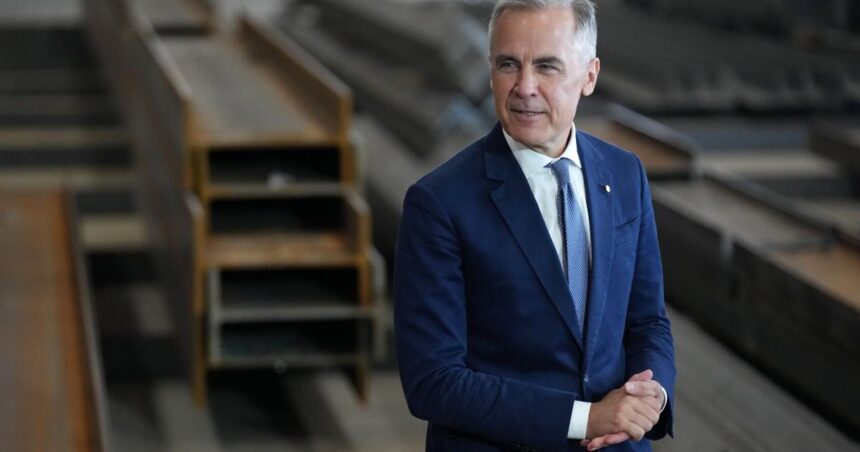Article – The grinding sound of idle machinery echoed through Hamilton’s ArcelorMittal Dofasco plant as Mark Carney announced a $1.75 billion lifeline for Canada’s beleaguered steel industry. Standing before workers whose livelihoods hang in the balance, the Finance Minister’s message was unambiguous.
“Steel is the very foundation of Canada,” Carney declared, his voice carrying across the cavernous factory floor. “These measures aren’t just about protecting jobs—they’re about protecting communities, supply chains, and our national sovereignty.”
The comprehensive aid package arrives at a critical moment. Canadian steel producers have struggled to maintain operations since the Biden administration reimposed 25% tariffs on Canadian steel and aluminum imports in June. The sudden policy reversal from Washington sent shockwaves through steel towns from Hamilton to Sault Ste. Marie, threatening thousands of jobs and disrupting integrated continental supply chains.
According to data from Statistics Canada, the sector employs over 23,000 Canadians directly and supports approximately 100,000 indirect jobs. The economic ripple effects stretch far beyond factory walls. In Hamilton alone, where steel production has defined the city’s identity for generations, one in eight jobs connects to the industry.
“We’ve weathered many storms before, but this one hits differently,” explained Jennifer Robertson, a third-generation steelworker at Dofasco. “My grandfather, my father, and now me—we’ve all made our living here. These tariffs aren’t just numbers on a spreadsheet; they’re threatening our way of life.”
The government’s rescue package includes $800 million in direct emergency funding for affected companies, $500 million for worker retraining programs, and $450 million for innovation investments aimed at greening steel production. The remaining funds will support regional economic development initiatives in communities heavily dependent on steel manufacturing.
Critics from opposition parties have questioned the timing of the announcement, suggesting it’s politically motivated. Conservative leader Pierre Poilievre characterized the package as “too little, too late” and accused the Liberal government of failing to maintain strong relationships with American trade partners.
International trade experts offer a more nuanced perspective on the situation. Dr. Amelia Santos of the C.D. Howe Institute points out that Canada faces a complex diplomatic challenge. “The U.S. decision wasn’t made in isolation. It reflects growing protectionist sentiment across multiple administrations and broader concerns about global steel overcapacity, particularly from China,” Santos explained.
The United States Trade Representative justified the tariffs by citing national security concerns, though many analysts view this as pretext for protecting domestic producers. The U.S. steel industry has faced its own struggles with aging infrastructure and international competition.
Canada’s response includes both domestic support and international pressure. Foreign Affairs Minister Mélanie Joly confirmed that Canada has filed a challenge under the USMCA trade agreement and is exploring additional retaliatory measures if diplomatic solutions fail.
“We’re pursuing every available avenue,” Joly stated. “The integrated nature of our economies means these tariffs ultimately harm American businesses and consumers too.”
The situation has revealed vulnerabilities in Canada’s industrial policy. Dr. Mark Rowlinson, former United Steelworkers counsel and now researcher at McMaster University’s Labour Studies Department, argues that Canada needs a more robust long-term strategy.
“For decades, we’ve assumed that free trade would naturally protect our integrated industries,” Rowlinson said. “This crisis demonstrates why Canada needs a comprehensive industrial policy that includes contingency planning for trade disruptions.”
Carney’s announcement appears to acknowledge these concerns. Beyond immediate relief, the package includes funding for technological modernization that could make Canadian steel production more competitive globally.
“The green steel transition represents both a challenge and an opportunity,” Carney noted. “With the right investments now, Canada can emerge as a global leader in low-carbon steel production.”
Environmental groups have cautiously welcomed this aspect of the package. The Canadian Climate Institute estimates that decarbonizing steel production could reduce national industrial emissions by up to 7% while creating new export opportunities as global buyers increasingly prioritize low-carbon materials.
For workers in Hamilton, Sault Ste. Marie, and other steel communities, the policy debates feel distant compared to immediate concerns about job security. Union representatives report increasing anxiety among members as production schedules remain uncertain.
“We appreciate the government’s support, but what we really need is market stability,” said Carlo Berardi, local United Steelworkers president. “Our members want to work, not collect assistance.”
As Carney concluded his announcement, he emphasized the broader significance of the struggle. “This isn’t just about steel—it’s about who we are as a nation. Canada builds things. We make things. And we’ll continue fighting to ensure Canadian workers and industries can compete fairly on the global stage.”
The coming months will test whether this aid package can effectively bridge the gap until a more permanent solution emerges. For Canada’s steel communities, much more than metal is being forged in this crisis—their very futures hang in the balance.






